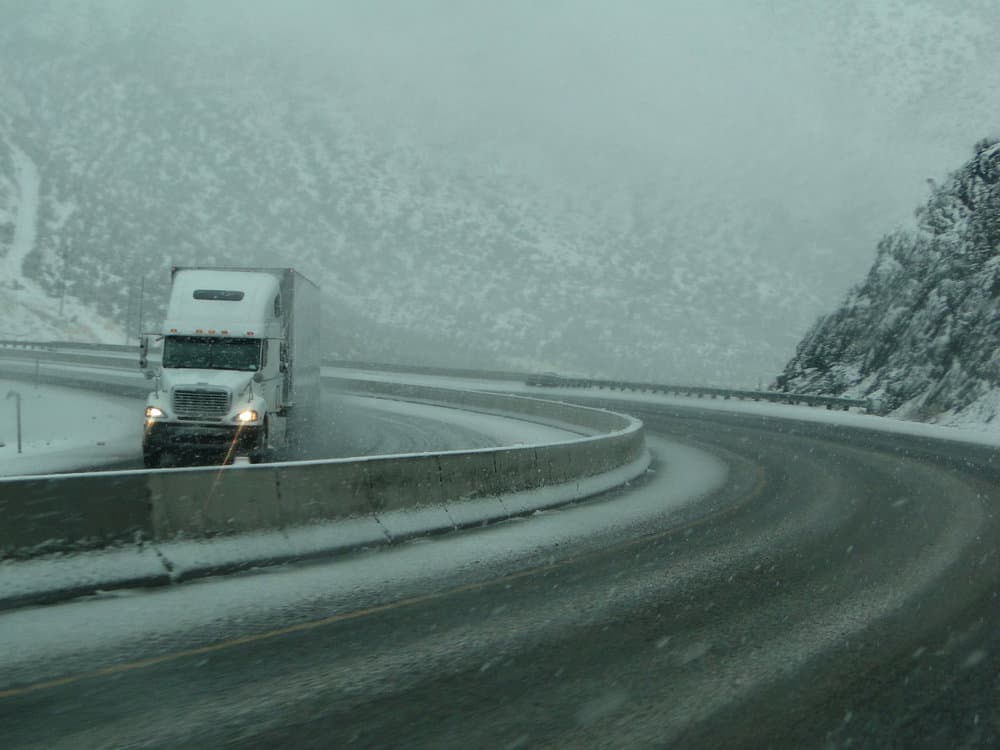
From driver health concerns to snow build-up on equipment, braving the winter months often requires carriers to plan in advance. Spireon hosted a webinar in collaboration with FreightWaves earlier this week to offer carriers tips on how to best prepare their drivers and their fleets for winter weather.
The webinar, dubbed “Winter is Coming: Preparing Your Feet & Drivers For Winter,” featured FreightWaves Chief Insight Officer Dean Croke, tackling driver preparation, and Erb Group Director of Safety and Compliance Tom Boehler, speaking on fleet preparation.
Croke encouraged carriers to consider schedule design, including which days drivers have on or off and start times, when preparing their driver forces for the winter months.
“Not all miles and hours are the same. So as managers in a trucking company, you need to think about winter slightly differently, not just from the hazards that drivers are exposed to, but from how they approach their work tasks,” Croke said. “Drivers are creatures of habit, and one of the things they really strive for is what we call ‘anchor sleep,’ which is sleep at the same time and in the same place every day. That means that start times for drivers need to be really consistent. Your risk for accidents goes up exponentially when you start to change drivers start times every day.”
Croke also encouraged carriers to be aware of seasonal affective disorder, a mental health disorder that he estimated affects between 5% and 15% of drivers each year.
SAD is a mood disorder that is characterized by depression that starts at the same time each year, during the colder months when people are exposed to less sunlight. Symptoms of the disorder include low energy, sleep issues, irritation, tiredness and changes in weight and appetite.
The lower levels of light exposure in the fall and winter months is thought to cause SAD by disrupting the body’s internal clock, leading to feelings of depression. Melatonin levels can also be affected. Treatments include light therapy, psychotherapy and medication.
“My word of advice for you: Don’t just brush this off as a yearly feeling or what drivers call the ‘winter blues.’ It can actually be really, really serious,” Croke said. “If drivers aren’t getting the right quality sleep, it doesn’t really matter how much safety training you provide.”
When it comes to preparing fleets for winter, Boehler said there are several areas carriers need to consider, including equipment, chaining laws, trip planning, driver behavior and snow build-up.
Making sure equipment is up to par is an important part of ensuring a fleet can withstand the low temperatures, ice and snow that come with the winter months. Boehler said there are 12 essential items to check, including:
-
Radiators
-
Tires
-
Wiper blades
-
Heater and defroster
-
Lights
-
Brakes
-
Muffler and exhaust
-
Battery
-
Fifth-wheel lubrication
-
Windows and mirrors
-
Froken brakes
–Drain air tanks
12. Bunk heater
–Operation/cleanliness/exhaust pipe
“We’ve found that, with a lot of bunk heaters, drivers wait until the last minute, and they’re clogged up with debris and dirt,” Boehler said. “So, getting those bunk heaters cleaned and making sure they’re working before you get into the winter is very important.”
Navigating winter weather can be much more efficient when both dispath and drivers employ forward-thinking trip planning. For dispath, this means being aware of weather conditions, estimating extra time and considering snow build-up on trailers. For drivers, it means allowing extra time based on the weather forecast, strategically planning rest stops and packing extra food, water and blankets in case they become stranded, according to Boehler.
“We’ve found it goes a long way for showing support and understanding with the drivers if we’re prepared and we can respond to them when [delays] occur,” Boehler said.
Carriers are drivers alike should ensure they have proper chain or traction devices on their tires and be aware of tire chaining regulations of each U.S. state or Canadian province they will be traveling through.
Boehler said it is important for carriers to review these regulations on an annual basis, as they may change. For example, British Columbia, Canada recently passed a law that requires all tires have chains, not alternative traction devices.
Another important step in preparing fleets for the colder months is ensuring drivers are aware of the hazards that accompany winter weather, including poor traction, reduced stopping ability, steering and stopping, slippery surfaces, reduced ability to see and be seen and jackknifing.
Boehler said the best way to help drivers navigate these hazards is to remind them of skillful driving techniques, including:
-
Smooth starts
-
Speed controls
-
Caution on hills
-
Curves and steering
-
Pavement markings
-
Lane changes
-
Stopping with ABS
-
Stopping without ABS
-
Tractor-trailer steering and fifth-wheel lubrication
-
Underpasses
-
Following distance
Finally, Boehler addressed the growing issue of snow build-up on equipment. Some states and provinces are cracking down on the issue and holding drivers and carriers responsible. He said carriers should encourage drivers to stationary trailer scraper blades when they are provided at weigh stations, which is common in some eastern provinces, like New Brunswick, Canada.
He also encouraged carriers have a game plan for dealing with snow build-up on dropped trailers at shippers’ locations.










